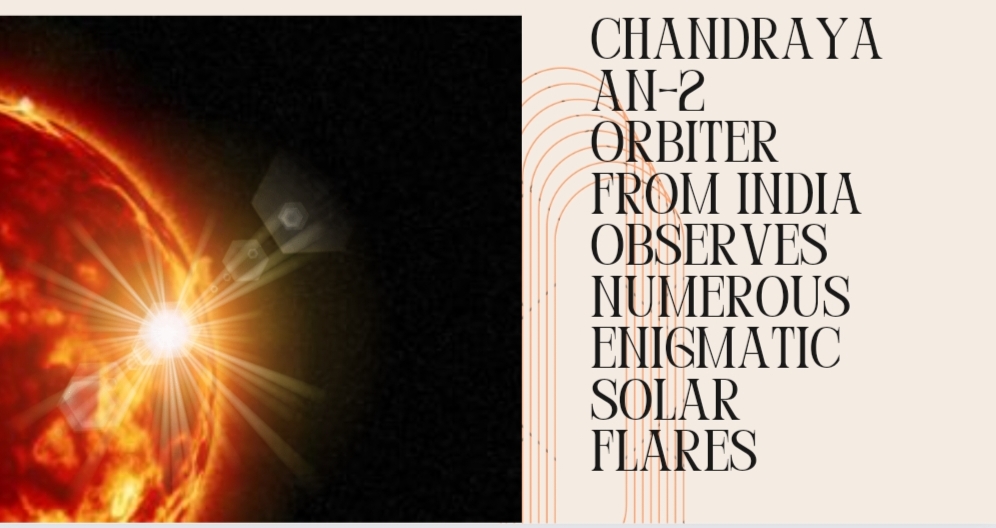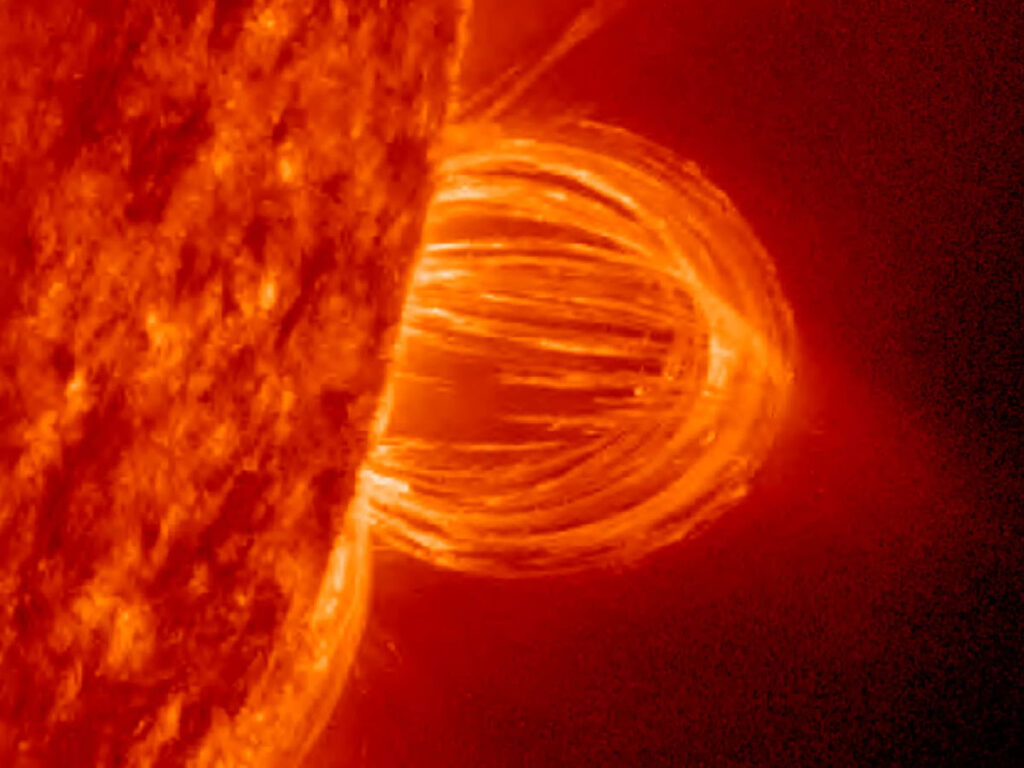
The latest detailed list of slow-developing solar flares, compiled since the 1980s, reveals that not all solar flares happen quickly.”
Recent research has produced a thorough list of enigmatic, slow-forming, and extremely hot explosions originating from the sun’s atmosphere. The results indicate that a significant number of these peculiarly sluggish flares, identified since the 1980s, require further examination.
Solar flares happen when the sun’s magnetic field lines get twisted or tangled around dark areas called sunspots. When these lines snap and reconnect, they release bursts of energy. These bursts can be strong enough to harm satellites and affect power and communication systems on Earth.
Traditionally, solar flares are classified based on how much energy they release and how long they last. However, this new research looked at how quickly the energy builds up in solar flares. It found that many solar flares don’t release energy as quickly as we thought. Instead of being sudden like the snap of a whip, they build up slowly and then fade away.

Using the Chandrayaan-2 lunar orbiter, a team of researchers identified 1,400 slow-rising flares over a span of three years. This significantly expanded the catalog of slow flares, which previously only contained around 100 such events observed over the last 40 years of solar research.
Aravind Bharathi Valluvan, a graduate student in astrophysics at the University of California, San Diego, explained that until recently, most solar physicists believed that solar flares followed a pattern of rapidly rising intensity followed by a slow decay. However, Valluvan’s research, along with their team, challenged this idea.
They found that the solar physics community had overlooked slower-rising flares, known as “hot thermal” flares, because the computer algorithms used to detect solar flares focused on fast-rising, or “impulsive” flares. These impulsive flares cover the maximum area in less than half of their lifespan.
Valluvan emphasized that their team took a different approach, looking at flares more broadly. They discovered that there are many more slow-rising flares than previously thought, making up about a quarter of all flares. This suggests that hot thermal flares should be studied separately because our current understanding of these slower flares is limited.
Table of Contents
ToggleWhat causes slow-rising flares to be enigmatic?
Slow-rising flares are puzzling because they’re supposed to happen quickly due to a fast process called magnetic reconnection. However, they take their time. Scientists want to know how these flares form, move through the sun’s outer layer, and why they’re so hot.
One weird thing about slow flares is that they’re super hot, even hotter than the quick ones. Quick flares can reach temperatures of about 18 million degrees Fahrenheit, while slow ones can be as hot as 54 million degrees Fahrenheit.
L'obiter #Chandrayaan2 della seconda missione indiana per l'esplorazione lunare non ha studiato solo la Luna ma anche contribuito ad ampliare il catalogo dei #brillamentisolari https://t.co/CGLoXfvMmi pic.twitter.com/LXixPKH4nZ
— Alive Universe (@_AliveUniverse) February 7, 2024
The sun’s atmosphere is very chaotic with lots of turbulent activity and swirling magnetic fields. Quick solar flares happen because of this turbulence, where energy is injected rapidly.
Slow flares might happen due to a different process, not relying so much on turbulence but more on heat and magnetism.
Also, the research shows that there aren’t any flares in between the fast and slow types. Scientists wonder why there’s this extreme difference.
Also Read | Acer’s 32-Inch Monitor: A Steal with the Latest Amazon Discount
Valluvan is trying to understand what causes these different types of flares and why they occur in such distinct ways.
Understanding slow-rising solar flares could help scientists solve a big puzzle: Why is the sun’s corona hotter than its surface, called the photosphere?
Even though the photosphere is closer to the sun’s core where nuclear fusion happens, the corona is hundreds of times hotter. Scientists have been puzzled by this for about fifty years.
For what reason is the sun’s air more sweltering than its surface?
Solar flares have been thought to explain this, but we never found proof,” Valluvan said. “These new kinds of bursts might solve this heating mystery. That’s what I’m most excited about.”

FaQ section:-
FaWhat are slow-developing solar flares, and why are they significant?
- Slow-developing solar flares are enigmatic explosions originating from the sun’s atmosphere that build up energy gradually. They are significant because they challenge traditional understandings of solar flare dynamics.
How are solar flares classified traditionally, and what did recent research reveal?
- Traditionally, solar flares are classified based on energy release and duration. Recent research revealed that the speed at which energy builds up in solar flares is also crucial for understanding their dynamics.
What is the role of magnetic reconnection in solar flares?
- Magnetic reconnection is a fast process where the sun’s magnetic field lines get twisted or tangled around sunspots. When these lines snap and reconnect, they release bursts of energy, causing solar flares.
What did the Chandrayaan-2 lunar orbiter contribute to the study of solar flares?
- The Chandrayaan-2 lunar orbiter helped identify 1,400 slow-rising flares over three years, significantly expanding the catalog of slow flares observed in solar research.
How did Valluvan’s research challenge traditional ideas about solar flares?
- Valluvan’s research challenged the traditional belief that solar flares follow a pattern of rapidly rising intensity followed by a slow decay. They discovered a significant number of slow-rising flares that were previously overlooked.
What distinguishes hot thermal flares from other types of solar flares?
- Hot thermal flares, also known as slow-rising flares, are characterized by their gradual build-up of energy and extremely high temperatures, reaching up to 54 million degrees Fahrenheit.
Why were slow-rising flares overlooked in previous solar research?
- Slow-rising flares were overlooked because most detection algorithms focused on fast-rising, or “impulsive,” flares, covering maximum area in less than half of their lifespan.
How does the chaotic nature of the sun’s atmosphere contribute to solar flare dynamics?
- The sun’s atmosphere is characterized by turbulent activity and swirling magnetic fields, contributing to the rapid injection of energy in impulsive solar flares.
What potential impact could understanding slow-rising solar flares have on solar physics?
- Understanding slow-rising solar flares could provide insights into the mechanisms behind solar flare generation and help solve long-standing mysteries, such as why the sun’s corona is hotter than its surface.
What is the significance of Valluvan’s statement regarding the potential resolution of the coronal heating mystery?
- Valluvan’s statement highlights the potential of slow-rising solar flares to provide answers to the long-standing puzzle of why the sun’s corona is hotter than its surface, offering new avenues for exploration in solar physics.



One thought on “Chandrayaan-2 Orbiter from India Observes Numerous Enigmatic Solar Flares”